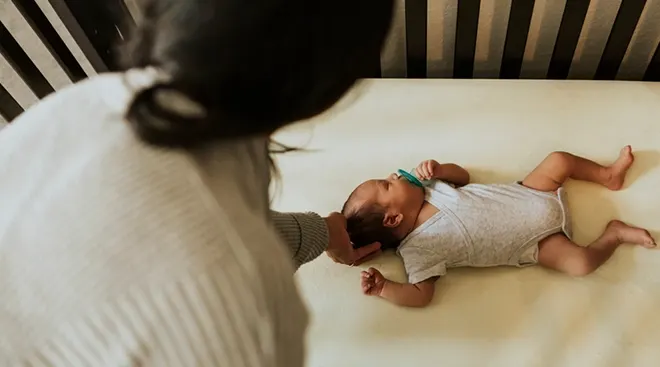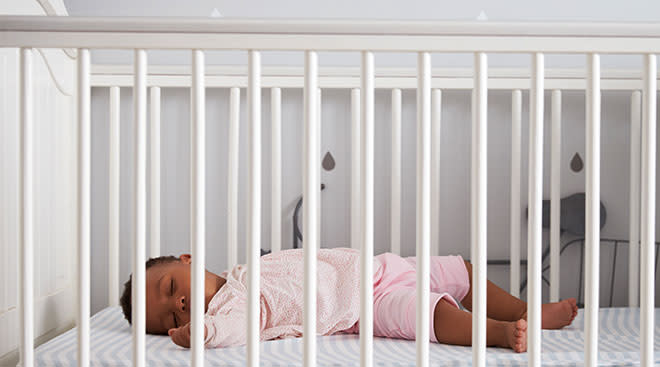Why Are SUID Incidents on the Rise Among Black Babies?
A shocking study from the Centers for Disease Control and Prevention (CDC) found a significant spike in sudden unexpected deaths (SUID) among Black babies during the COVID-19 pandemic.
According to the study, in 2020 the infant mortality rate among Black babies (214 fatalities per 100,000 live births) was nearly three times that of white infants (75.6 fatalities per 100,000 live births). The reasons are complicated.
“The ‘why?’ is multifactorial,” says Gabrina Dixon, MD, MEd, a pediatrician at Children’s National Hospital and an associate professor of pediatrics at George Washington University School of Medicine and Health Sciences. “Some of this is due to systemic racism and bias, but this is [also] a public health issue, especially for infants.” Below, we take a deeper dive into the potential reasons behind this spike, and share some steps parents can take to prevent SUID incidents.
Sudden infant death syndrome or SIDS is the original term used to describe deaths of infants under 12 months that occur suddenly and unexpectedly. The distinction between the terms SIDS and SUID can be challenging, according to the American Academy of Pediatrics (AAP). Essentially, SUID is an umbrella term that includes SIDS, as well as situations such as accidental suffocation during sleep and other deaths from unknown causes. Both SIDS and SUID only apply to infants under one, says Gina Lowell, MD, MPH, an associate professor and director of community health for pediatrics at Rush University Children’s Hospital.
According to the CDC, around 3,400 babies die from SUID each year. The rate has decreased steadily over the past few decades since the success of the 1994 “Back to Sleep” campaign, a national initiative known today as Safe to Sleep that encourages parents and caregivers to place babies on their backs for sleeping, as it’s the safest option.
The CDC study found that while there was a 15 percent increase in SIDS across babies of all races from 2019 to 2020, the overall SUID rate didn’t significantly increase—and there was a record-low US infant mortality rate. The disparity in terminology has made things more challenging for researchers: Study authors noted that the difference in terms could have caused the reported increase in SIDS cases. “There were medical examiners and coroners’ offices certifying these deaths who were really overburdened by pandemic-related deaths,” says Commander Sharyn Parks, PhD, MPH, a senior epidemiologist in the CDC’s Division of Reproductive Health. “It’s very plausible that things directly related to the pandemic impacted their ability to be thorough and do the investigating that SUID cases needed.”
Kate Selmeck, a pediatric resident at the University of Illinois Hospital and Health Sciences System, says that the way suffocation deaths are classified changed in 2019 to fall under SIDs, which may have contributed to the higher reported SIDS rate. “
The upsurge in SUID for Black babies, however, cannot be explained with terminology differences. So what’s behind it? “It’s not clear based on the data that we had, and it’s something that would have to be tackled with a different type of research than what we’re able to do at the CDC,” says Parks. “We need more years of data to determine if it’s just a statistical anomaly or a true increase sustained over time.”
Babies in communities marked by “historical disinvestment” (i.e. lower socioeconomic families living in neighborhoods with limited resources) are more likely to experience risk factors that make them more susceptible to SUID, says Lowell, such as being born prematurely and being exposed to secondhand smoke during pregnancy and after birth. “There are so many factors that contribute to the health of an infant—household factors; access to trusted sources of health information; strong relationships within families; environmental factors like air quality, food security, housing stability,” says Lowell. “If you start to realize that disinvestment attacks all these factors, and that it’s happening in our communities of color, that shifts the focus from ‘Black infants are dying at much higher rates than white infants’ to ‘Families that experience this level of disinvestment will also experience health outcomes that disproportionately affect them.’”
Additionally, Black families were disproportionately affected by COVID-19, and had less access to quality healthcare for well-baby visits due to lack of health insurance and transportation issues, which meant less safe-sleep messaging. Crowded living situations and changes in childcare could also have contributed to unsafe sleeping conditions. “The idea that families who were really struggling to survive were capable of taking the precautions for safe sleep—that ability may have been compromised for certain families,” says Parks.
Some municipalities and locales like Cook County in Illinois have started to work closely with coroners and medical examiners to better understand the circumstances surrounding sudden infant deaths, says Lowell. This helps communities zero in on what factors may be impacting babies’ health. Cook County officials and Rush University Medical Center are providing tailored SUID prevention messaging and other healthcare help at community events, says Lowell.
Nationally, pediatricians are being trained to better understand the social determinants surrounding SUID, says Selmeck. “It’s about understanding that there’s more to a patient and family when they come in for a well visit than just the child’s health,” she says.
Lowell says there are things parents and caregivers can do at nap and bedtime to prevent SUID. First, stick to the safe sleep basics that the AAP recently updated:
- Place baby on their back for all naps and nighttime sleep
- Baby should sleep on a firm, flat surface, and not use products that aren’t specifically marketed for sleep
- Keep baby’s sleep space free of blankets, toys, pillows and other items
- Don’t use devices like car seats, infant swings, strollers, carriers and slings for baby’s regular sleep. Nodding off during car rides is fine, but if baby falls asleep in one of these places at home, move them to their bedtime space as soon as you can
- If possible, try to sleep in the same room—but not in the same bed—as baby until they’re at least 6 months old
- Use a pacifier if baby will take it. Pacifiers have been associated with reducing the risk of SUID
- Don’t rely on any products that claim to reduce the risk of SUID
- Give baby plenty of tummy time when they’re awake and someone is watching them
- Make sure baby gets routine checkups as recommended by your pediatrician
- Avoid smoking, excessive drinking and drug use at home
- Stop swaddling when baby starts to roll, typically at about 3 or 4 months
Lastly, talk to your healthcare provider and be upfront about how your family actually sleeps, says Stacy Laurent, DO, assistant professor of clinical pediatrics at the University of Illinois Hospital and Health Sciences System. “The reality of what happens at home is so much more complicated than how the guidelines have been written,” says Laurent. “Anything related to parenting is so hard and we all try to normalize how hard it is, which makes it [difficult] to have conversations without feeling like we’re being judged about what we’re doing.”
Please note: The Bump and the materials and information it contains are not intended to, and do not constitute, medical or other health advice or diagnosis and should not be used as such. You should always consult with a qualified physician or health professional about your specific circumstances.
Plus, more from The Bump:
Gabrina Dixon, MD, MEd, is a pediatric hospitalist at Children’s National Hospital in Washington, DC, and an associate professor of pediatrics at George Washington University School of Medicine and Health Sciences. She earned her medical degree from Howard University College of Medicine.
Gina Lowell, MD, MPH, is an associate professor and director of community health for pediatrics at Rush University Children’s Hospital. She earned her medical degree from Rush Medical College.
Kate Selmeck is a pediatric resident at the University of Illinois Hospital and Health Sciences System.
Stacy Laurent, DO, is an assistant professor of clinical pediatrics at the University of Illinois Hospital and Health Sciences System. She earned her medical degree from Midwestern University.
American Academy of Pediatrics, Sudden Unexpected Infant Deaths: 2015–2020, March 2023
American Academy of Pediatrics, SIDS and Other Sleep-Related Infant Deaths: Updated 2016 Recommendations for a Safe Infant Sleeping Environment, November 2016
Centers for Disease Control and Prevention, Sudden Unexpected Infant Death and Sudden Infant Death Syndrome, Data and Statistics, March 2023
US Department of Health and Human Services, Safe to Sleep
American Academy of Pediatrics, American Academy of Pediatrics Updates Safe Sleep Recommendations: Back is Best, June 2022
Learn how we ensure the accuracy of our content through our editorial and medical review process.
Navigate forward to interact with the calendar and select a date. Press the question mark key to get the keyboard shortcuts for changing dates.




















































